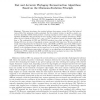Free Online Productivity Tools
i2Speak
i2Symbol
i2OCR
iTex2Img
iWeb2Print
iWeb2Shot
i2Type
iPdf2Split
iPdf2Merge
i2Bopomofo
i2Arabic
i2Style
i2Image
i2PDF
iLatex2Rtf
Sci2ools
JCB
2002
2002
Fast and Accurate Phylogeny Reconstruction Algorithms Based on the Minimum-Evolution Principle
This paper investigates the standard ordinary least-squares version 24 and the balanced version 20 of the minimum evolution principle. For the standard version, we provide a greedy construction algorithm GME which produces a starting topology in On2 time, and a tree swapping algorithm FASTNNI that searches for the best topology using nearest neighbor interchanges NNIs, where the cost of doing p NNIs is On2 + pn, i.e. On2 in practice because p is always much smaller than n. The combination of GME and FASTNNI produces trees which are fairly close to Neighbor Joining NJ trees in terms of topological accuracy, especially with large trees. We also provide two closely related algorithms for the balanced version, called BME and BNNI, respectively. BME requires On2 diamT operations to build the starting tree, and BNNI is in On2 + pn diamT, where diamT is the topological diameter of the output tree. In the usual Yule-Harding distribution on phylogenetic trees, the diameter expectation is in lo...
Algorithms | Balanced Version | JCB 2002 | Tree |
| Added | 22 Dec 2010 |
| Updated | 22 Dec 2010 |
| Type | Journal |
| Year | 2002 |
| Where | JCB |
| Authors | Richard Desper, Olivier Gascuel |
Comments (0)

